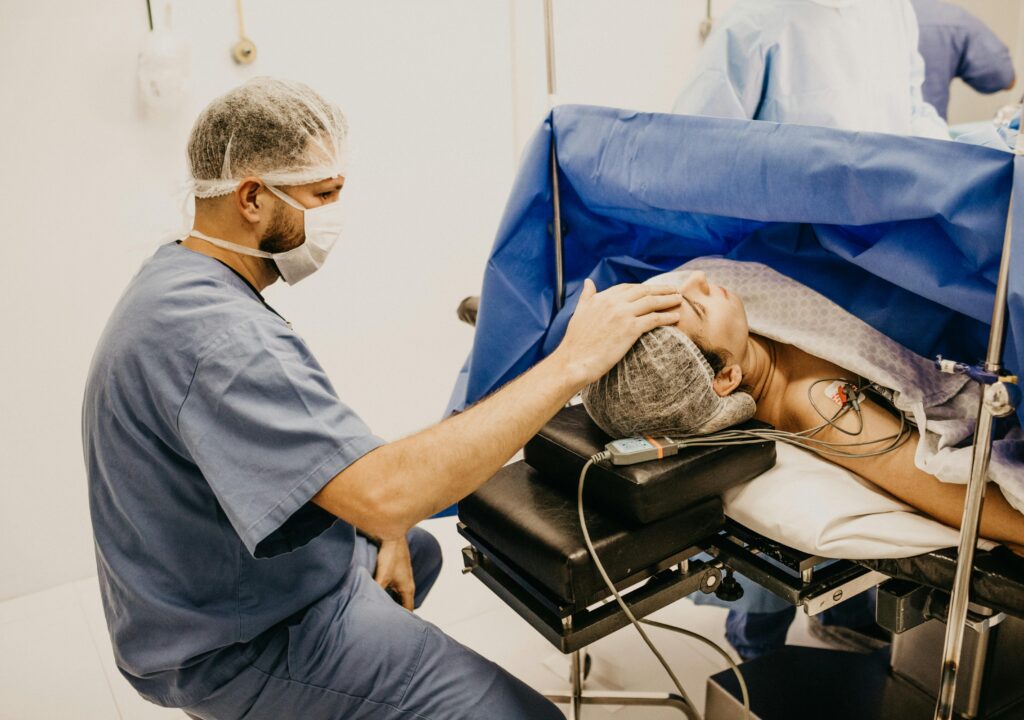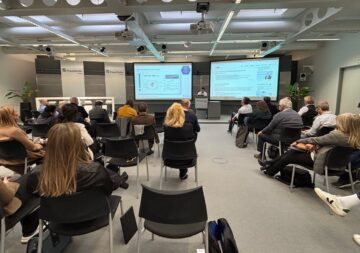
Nurses working in anesthesia care are nurses who work in the operating room, taking care of patients during their surgeries. Nurse roles and places of employment, however, are much wider and broader than the general perception. In this article, the education and role of the anesthesia nurse in Finland and the nurse anesthetist in the United States are compared. LAB University of Applied Sciences provides an anesthesia nurse specialist programme for nurses.
Authors: Madge E. Moon & Hannele Tiittanen
Nurse anesthetists perform specialized work in operating rooms and intensive care, which require advanced competencies for delivering anesthesia, providing pain management and other anesthesia services inside and outside the hospital for patients of all ages (ICN 2021). Anesthesia specialty can be divided into four main areas: operating room anesthesia, pain management, intensive care and pre-hospital emergency care (Huhtala et al. 2024).
The nurse anesthetists’ roles, responsibilities, and skills differ in varying countries, from an independent and broad scope to a limited and supervised scope of practice (Pann et al. 2025). Also, the terminology varies when referring to nurses who give anesthesia; “anesthesia nurse”, “anesthesia nurse specialist”, “nurse anesthetist”, do not necessarily denote the same skillset, but the same basic ideology, in that a nurse is giving anesthesia care. All of the titles encompass vastly different educational levels and scopes of practice, nurse anesthetists have a master’s or doctorate education, and anesthesia nurses have a bachelor level education, which reflects on how independently nurses can deliver anesthesia services (Huhtala et al. 2024).
The United States (the U.S.) is widely recognized for its Certified Registered Nurse Anesthetist (CRNA) profession, requiring an advanced practice nursing (APN) degree, which currently is at the doctoral level. An advanced practice nurse is a nurse who, after additional demanding education, possesses advanced knowledge, decision-making abilities, and clinical skills for expanded nursing roles (ICN 2021, 2020).
Several European countries recognize the role of nurse anesthetists, who have a nursing degree and specialized anesthesia training; however, their roles and training vary by country, and their scope of practice and autonomy differ from the U.S. LAB University of Applied Sciences had a visiting Nurse Anesthetist (CRNA) from the U.S. lecturing at the beginning of the fall semester 2025. This provided the possibility to compare the nurse anesthetist education. This article focuses on explaining the differences between the nurse anesthesia training and scope of practice in both countries and to reflect future perspectives.
Different Pathways in U.S and Finland
In the U.S, nurse anesthetists follow a clearly defined path regulated by national certification and accreditation organizations. The process generally consists of obtaining a Bachelor of Science in Nursing (BSN), acquiring at least one year of critical care experience as a registered nurse, completing an accredited nurse anesthesia program, which as of 2025 must confer a Doctor of Nursing Practice (DNP) or Doctor of Nurse Anesthesia Practice (DNAP) degree. In addition, it is required to pass the National Certification Examination (NCE). The total educational journey typically spans 7–10 years from undergraduate studies to certification. (COA 2025; AANA 2025.)
Finnish nurses working in anesthesia are commonly called anesthesia nurses, and are trained in 3.5-year Bachelor’s degree education in nursing and are registered to have a license to work as a nurse in Finland (Suomen Sairaanhoitajat 2025a; Valvira 2025). Gaining experience in clinical practice, it is possible to apply to post-graduate specialization studies in anesthesia nursing leading to a professional diploma or certification, often lasting 6 months to 1 year. The process typically takes 4–5 years of post-secondary education (Suomen Sairaanhoitajat 2025b). It is noteworthy that specialization studies are not mandatory to be employed as an anesthesia nurse.
In the U.S., nurse anesthesia programs are standardized, and programs typically last 3 years requiring a minimum of 600 anesthetic cases across all patient age groups and specialties. Training includes preoperative assessment, anesthesia induction and maintenance, pain management and regional anesthesia, and care for complex cases of cardiac, obstetric, pediatric, and trauma patients. The scope of practice is large as they are educated to deliver comprehensive anesthesia care independently, CRNAs practice in all settings, including autonomous roles in many U.S. states (COA 2025; AANA 2020).
In Finland the clinical competence requirements for an anesthesia nurse includes aseptic skills, emergency care, patient safety, pain management, knowledge of different forms of anesthesia, securing vital functions and drug therapy (Suomen Anestesiasairaanhoitajat 2025.) Anesthesia nurses training and scope of practice is limited compared to CRNAs’ as they do not independently administer anesthesia. Table 1. presents the main contents of nurse anesthetists and anesthesia nurses’ competence areas. The differences are notably in the amount of anatomy, physiology, and pathophysiology as well as in diagnostics and patient assessment which are not included in Finnish anesthesia nurse competencies.
| Nurse Anesthetists, CRNA (COA 2023) | Anesthesia nurse (Suomen Anestesiasairaanhoitajat ry 2025) |
|---|---|
| -Advanced anatomy, physiology, and pathophysiology | -Advanced pharmacology of anesthetics and analgesics |
| -Pharmacology, especially anesthetic agents | -Knowledge of different forms of anesthesia, securing vital functions and drug therapy |
| -Principles and practices of anesthesia for diverse populations | -Pain management |
| -Diagnostics, assessment, and perioperative care | -Aseptic skills |
| -Professional practice, ethics, and leadership | -Emergency care |
| -Research and evidence-based practice | -Ethics and legislation |
| -Patient safety | |
| -IT systems and documentation | |
| -Economics, ecology and efficiency |
Table 1. Main contents in nurse anesthetists’ competence areas in the U.S. and anesthesia nurse in Finland.
CRNAs must be recertified every four years through the Continued Professional Certification program (NBCRNA 2024). They are recognized as advanced practice providers with significant autonomy and compensation (AANA 2024). Finnish anesthesia nurses maintain licensed and registered nurses and demonstrate ongoing competence through employer-provided training and education (Suomen Sairaanhoitajat 2021). Different Universities of Applied Sciences provide professional continuous training for nurses working in anesthesia, but they vary with their length and content. Commonly, each anesthesia department trains their novice nurses with their department’s own on the job orientation programme. (Jeon 2021.)
LAB provides a 30 ECTS specialized program, the Anesthetic Nurse Specialist, which confers a certificate upon completion. The programme consists of 15 ECTS clinical anesthesia competence including clinical training, 5 ECTS modules of development and consultation competence, acting in emergency and acute situations, and teamwork and working life competence. (LAB-ammattikorkeakoulu 2025.) The programme has been recognized only one in Finland, by the International Federation of Nurse Anesthetists, which is a global organization representing the specialty of nurse anesthetists (IFNA 2025).
Challenges and Future Directions
Differences in the anesthesia nurses’ education, role and scope of practice has led to a need to standardize the anesthesia nurse education. The International Council of Nurses recommends that there should be at least one year of specialized training for anesthesia nurses (ICN 2021). Anesthesia nursing education in Finland should follow with the other Nordic countries where the education confers master’s degree, ensuring advanced and specialized knowledge in anesthesia care and a wider scope of practice (Huhtala et al 2024). This opportunity would strengthen nurses’ professional identity, increase job satisfaction, support the use of evidence-based practice, and would be essential for advancing anesthesia nursing research. A nurse who has completed a clinical master’s degree (YAMK) has a possibility to become a broad-responsibility specialist, an Advanced Nurse Practitioner. (Finnish Nurses Association 2023.)
The Finnish Nurses Association and the Finnish Association of Nurse Anesthetists demand the launch of specialized training for anesthesia nurses in their outcome August 19th 2025. Finnish nurse anesthesia training should meet international standards, recommendations and practices. Education would bring benefits by reducing the workload of experienced staff, improving patient safety, and ensuring consistent, evidence-based training. Higher education degree programme would guarantee that graduates are properly trained and function with a wider scope of practice. (Suomen Sairaanhoitajat 2025c.) In addition, higher education training allows for international collaboration and mobility possibilities that would benefit networking and development of nurse anesthesia practice globally. LAB’s strong Anesthetic Nurse Specialist programme has been developed systematically in response to the growing healthcare needs and fulfilling the educational gap in anesthesia nurse education in Finland.
References
AANA. 2024. Become CRNA. American Association of Nurse Anesthesiology. Cited 19 August 2025. Available at https://www.aana.com/about-us/about-crnas/become-a-crna/
AANA. 2020. Scope of Nurse Anesthesia Practice. American Association of Nurse Anesthesiology. Cited 19 August. Available at https://www.aana.com/wp-content/uploads/2023/01/scope-of-nurse-anesthesia-practice.pdf
COA. 2025. Accreditation Standards, Policies and Procedures, and Guidelines. Council on Accreditation of Nurse Anesthesia Educational Programs. Cited 20 August. Available at https://www.coacrna.org/accreditation/accreditation-standards-policies-and-procedures-and-guidelines/
Finnish Nurses Association. 2023. Advanced Practice Nursing in Finland – a clinical nursing career model. Cited 21 August 2025. Available at https://sairaanhoitajat.fi/wp-content/uploads/2024/09/APN-report-2023-English.pdf
ICN. 2021. Guidelines on Advanced Practice Nursing – Nurse Anesthetists. International Council of Nurses. Cited 23 August 2025. Available at https://www.icn.ch/system/files/documents/2021-05/ICN_Nurse-Anaesthetist-Report_EN_WEB.pdf
ICN. 2020. Guidelines on Advanced Practice Nursing. International Council of Nurses. Cited 22 August. Available at https://www.icn.ch/sites/default/files/2023-04/ICN_APN%20Report_EN.pdf
IFNA 2019. Anesthetic Nurse Specialist, LAB University of Applied Sciences, Finland. International Federation of Nurse Anesthetists. Cited 26 August. Available at https://ifna.site/anesthesia/anesthetic-nurse-specialist-lahti-university-of-applied-sciences-finland/
Jeon, Y. 2021. Competence assessment in anaesthesia nursing care. Väitöskirja. Turun yliopisto. Turku. Turun yliopiston julkaisusarja D, 1573. Cited 4 September. Available at https://urn.fi/URN:ISBN:978-951-29-8573-9
Huhtala, O., Kunttu, T., Sourulahti, R. 2024: Sairaanhoitajakoulutuksen jälkeinen anestesiahoitotyön koulutus ja osaaminen pohjoismaissa. YAMK-opinnäytetyö, sosiaali- ja terveysala. Oulun ammattikorkeakoulu. Oulu. Cited 23 August Available at https://urn.fi/URN:NBN:fi:amk-2024060420941
LAB-ammattikorkeakoulu. 2025. Anestesiahoitotyöhön erikoistunut osaaja – Anesthetic Nurse Specialist. Cited 26 August. Available at https://www.lutuniversities.fi/fi/taydennyskoulutus/anestesiahoitotyohon-erikoistunut-osaaja-anesthetic-nurse-specialist
NBCRNA. 2024. Maintaining Anesthesia Certification. National Board of Certification and Recertification for Nurse Anesthetists. Cited 20 August. Available at https://www.nbcrna.com/certification-programs/mac
Pann, K.A., Buchner, V-K., E ß l-Maurer, R., Bacher, T., Glarcher, M., Ewers, A. 2025. International Journal of Nursing Studies Advances. Vol. 8, 100319. Cited 26 August. Available at https://doi.org/10.1016/j.ijnsa.2025.100319
Suomen Anestesiasairaanhoitajat. 2025. Osaamisvaatimukset. Cited 20 August. Available at https://sash.fi/julkaisut/osaamisvaatimukset/
Suomen Sairaanhoitajat. 2025a. Opiskele sairaanhoitajaksi. Cited 21 August. Available at https://sairaanhoitajat.fi/ammatti-ja-osaaminen/opiskele-sairaanhoitajaksi/
Suomen sairaanhoitajat. 2025b. Sairaanhoitajan monet eri urapolut. Cited 21 August. Available at https://sairaanhoitajat.fi/ammatti-ja-osaaminen/sairaanhoitajan-monet-eri-urapolut/
Suomen Sairaanhoitajat. 2025c. Anestesiasairaanhoitajien erikoistumiskoulutus on käynnistettävä nopealla aikataululla. Cited 21 August. Available at https://sairaanhoitajat.fi/anestesiasairaanhoitajien-erikoistumiskoulutus-on-kaynnistettava-nopealla-aikataululla/
Valvira. 2025. Töihin sosiaali- ja terveysalalle. Sosiaali- ja terveysalan lupa- ja valvontavirasto. Cited 4 September. Available at https://valvira.fi/ammattioikeudet/toihin-sosiaali-ja-terveysalalle
Authors
Madge E. Moon, MBA, MSHCA, CRNA, practicing clinician, Atlanta, GA, USA
Hannele Tiittanen, Principal Lecturer, works in the Faculty of Wellbeing at LAB University of Applied Sciences.
Illustration: https://www.pexels.com/fi-fi/kuva/ammattilainen-laakari-terveys-sairaala-3279196/ (Jonathan Borba, Pexels-lisence)
Reference to this article
Moon, M.E. & Tiittanen, H. 2025. Comparison of Nurse Anesthetists’ Education and Role in Finland and the United States. LAB Pro. Cited and date of citation. Available at https://www.labopen.fi/en/lab-pro/comparison-of-nurse-anesthetists-education-and-role-in-finland-and-the-united-states/






